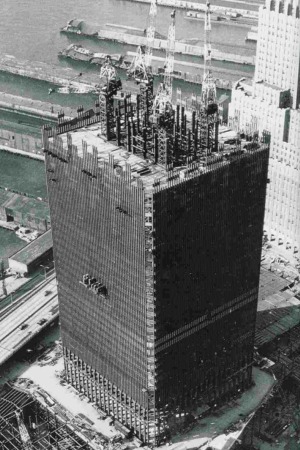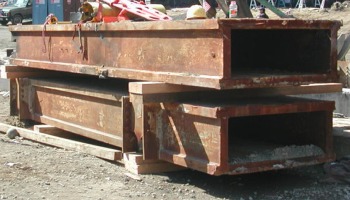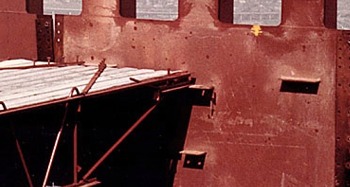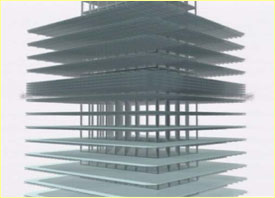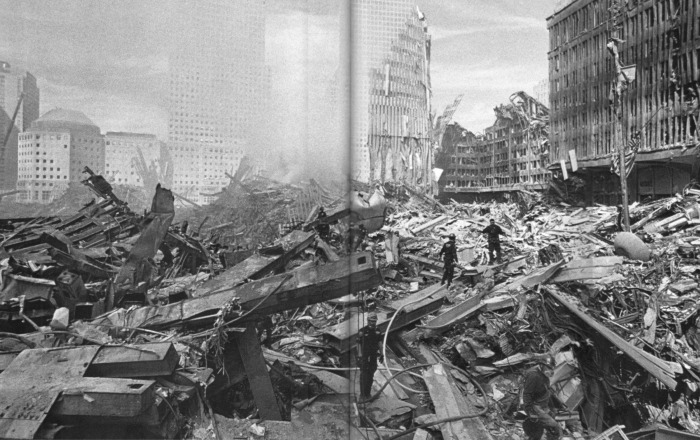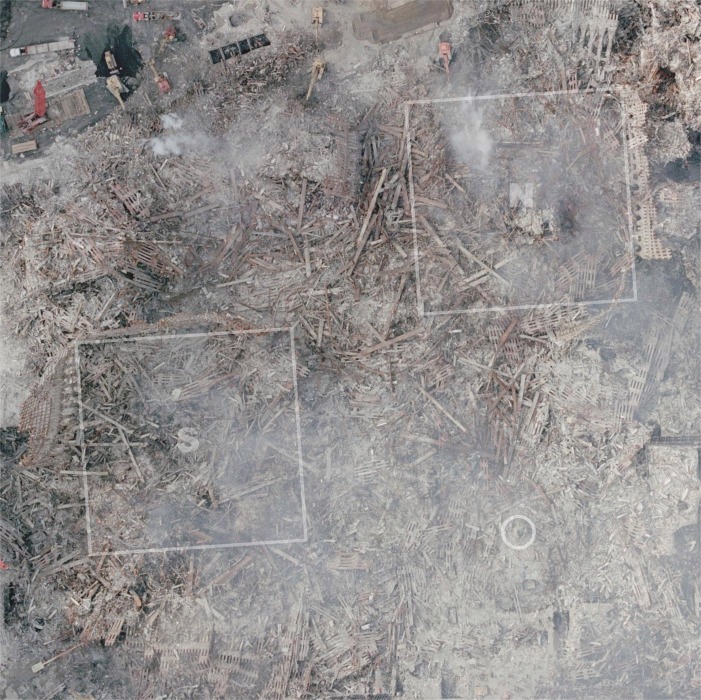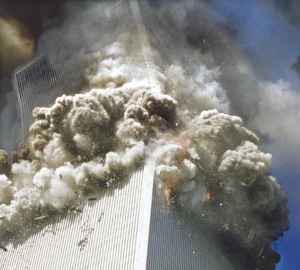| [Back to key points overview] | |||||||||||||||||||||||||||||||
| Flaws in the official 9/11 account — the explosive disintegration of the WTC twin towers | |||||||||||||||||||||||||||||||
1. Construction of the towers
2. Misinformation There has been a good deal of misinformation in the media and elsewhere about the tower collapses. This misinformation can be categorised as follows: 2.1. Misinformation about the structure of the towers
2.2. Claims that the towers were not designed to cope with this kind of event
"But steel melts, and 24,000 gallons (91,000 litres) of aviation fluid melted the steel. Nothing is designed or will be designed to withstand that fire."
- Hyman Brown (quoted by the BBC)
No designer of the WTC anticipated, nor should have anticipated, a 90,000 L Molotov cocktail on one of the building floors.
Consider this comment by Frank A. DeMartini (from an interview 8 months prior to 9/11):
The building was designed to have a fully loaded 707 crash into it... I believe that the building probably could sustain multiple impacts of jetliners...
- Frank A. DeMartini, Manager, WTC Construction & Project Management, 25 Jan 2001 (wmv-file)
Are we really expected to believe the WTC designers forgot about the small matter of the fuel load? A 767 is not very different in size and weight to a 707, and the two flights that hit the towers would have been carrying far less than a full fuel payload (as they were transcontinental flights). The government-sponsored investigations later admit that the fuel played no major role other than to ignite office contents over a widespread area. The fuel itself burned up too quickly to have a major impact on the steel. This leads into the next piece of misinformation...
2.3. Claims that the fires were 'raging infernos'
Below left: the towers viewed from the north. The north tower was hit from this side, the south tower was hit from the south (opposite) side. Below right: the north tower from the north again, but showing more of the east face.
"... it is believed that almost all of the jet fuel that remained on the impact floors was consumed in the first few minutes of the fire."
-- FEMA: World Trade Center Building Performance Study (Chapter 2, p. 2-22)
As FEMA freely admitted, the jet fuel would have burned off in minutes at most. All that was burning after this time was standard office furnishings.
2.4. Claims that collapse of the buildings was inevitable
"... the eventual collapse of the twin towers was so predictable that the order should have been given to withdraw emergency services within an hour."
- Professor John Knapton, Newcastle University, UK (quoted by the BBC).
We beg to differ. There were no signs that the buildings were in danger of collapsing following the impacts. Only about 15% of the perimeter columns were severely damaged. It is hard to believe that more then a handful of the 47 core columns could have been severely damaged by the predominantly lightweight aircraft structures. It has been reported that the steel structure of each tower was six times the strength needed to handle the predicted extreme load conditions. The jet fuel fireballs, while impressive, were short lived. The ensuing fires were no different to several other office fires that have been witnessed.
"WTC 2 displayed significant reserve capacity, as evidenced by a post-impact rooftop sway that was more than one-third of that under the hurricane force winds for which the building was designed. The oscillation period of this swaying was nearly equal to that calculated for the undamaged structure. "
- NIST NCSTAR 1, WTC Final Report (p. 182)
There is also no evidence that the fire fighters expected the towers to collapse. They were attempting to put out the fires at the time, and were taken completely by surprise. The initial advice given to occupants was to stay in the buildings. To say the collapses were inevitable when they were completely unprecedented seems to be being 'wise' after the event. The combined effect of this early misinformation (such as the BBC claim that jet fuel melted the steel) was to reassure the general public — who were shocked by the sudden and explosive collapses — that there was a rational explanation. Later investigations and reports have tended to present the information more accurately. But the early misinformation was significant in guiding our general perceptions of the event down the officially sanctioned path.
3. The 'investigations' 3.1. The FEMA investigation This initial investigation was described as a 'half-baked farce' by the chief editor of Fire Engineering magazine. It operated on a shoe-string budget with panel members working voluntarily in their spare time. It had no access to the site for the first 25 days after the event, and then only limited access thereafter. It had no authority to stop critical evidence being removed from the site. The Port Authority delayed giving the panel the blueprints for the towers for three months and required a legal indemnity to be signed. This information can be confirmed from the sources below (show/hide):
3.2. The NIST investigation
NIST had a much larger budget and spent over three years doing its investigation, but it started almost a year after the event. NIST was hampered by the same lack of access to physical evidence as the FEMA investigation, but probably more so, given their much later start.
"The scarcity of physical evidence that is typically available in place for reconstruction of a disaster led to the following approach ..."
- NIST NCSTAR 1, WTC Final Report (p. xxxvi)
NIST's approach was to base their investigation on photographic and video evidence, simulations (including actual fire modelling), and computer models. However, NIST did have access to some samples of steel identified as originating from the tower impact zones. So what did the only available physical evidence reveal about the intensity of the fires in the fire zones?
"Examination of photographs showed that 16 of the exterior panels recovered from WTC 1 were exposed to fire prior to the building collapse. None of the nine recovered panels from within the fire floors of WTC 2 were directly exposed to fire. NIST used two methods to estimate the maximum temperatures that the steel members had reached:
- NIST NCSTAR 1, WTC Final Report (p. 90)
To summarise, nine samples from WTC 2 were from the fire floors, but had not been directly exposed to fire. Only three WTC 1 perimeter colums out of the 16 represented by samples had been heated above 250 C. The two core column samples that could be analysed had not been heated above 250 C. The metallographic analysis showed that none of the samples had been heated above 600 C as an absolute upper limit (but did not necessarily indicate that anything even approaching this temperature was reached). The samples available for NIST's investigation were such a small percentage of the relevant steel that NIST, understandably, 'did not generalize these results'. How much faith can we have in a fire investigation that had almost no acces to the physical evidence, especially when the little physical material it did have seems to be at odds with its basic findings? How reliable were NIST's models? This is what Physics Professor, Steven E Jones, had to say about them:
... NIST constructs a computer model -- but realistic cases do not actually
lead to building collapse. So they "adjust" inputs until the model finally shows collapse
initiation for the most severe cases. The details of these "adjustments" are hidden from us, in
their computerized hypotheticals, but "the hypothesis is saved." NIST also has Underwriters
Laboratories construct models of the WTC trusses, but the models withstand all fires in tests and
do NOT collapse.
4. The theories Most significantly, none of the "experts" proposing these theories had access to the site immediately after the collapses to draw conclusions from the rubble and the final state of the towers. Access to the site was heavily restricted and even taking photos was strictly prohibited (show/hide quote): :
4.1. Pancake (floor) collapse One of the most prevalent theories in the months following 9/11 was the "pancake" collapse theory, put forward by Eagar and Musso (among others):
Many structural engineers believe that the weak points — the limiting factors on design allowables — were the angle clips that held the floor joists between the columns on the perimeter wall and the core structure [...]
As the joists on one or two of the most heavily burned floors gave way and the outer box columns began to bow outward, the floors above them also fell. The floor below (with its 1,300 t design capacity) could not support the roughly 45,000 t of ten floors (or more) above crashing down on these angle clips. This started the domino effect that caused the buildings to collapse within ten seconds... - Why Did the World Trade Center Collapse, Thomas W. Eagar & Christopher Musso, JOM, 53 (12) (2001), pp. 8-11.
Above left: Eager & Musso's diagram of a tower floor joist. Above right: construction photograph showing the outer edge of a joist. There are several weaknesses with this theory: 1. It is pure speculation that the collapse of the floor joists would cause or allow the perimeter columns to 'bow outward'. Each column had its own rigid box structure that would have resisted bending, and the 236 columns were also fixed into a rigid 'tubular' structure by interconnecting steel spandrels. 2. No mention is made of the 47 massive core columns. While it might be conceivable, under very extreme fire conditions, that the floor joists/trusses on one or more floors could collapse, this would have had very little impact on either the core columns or perimeter columns. 3. Eagar & Musso speak of "roughly 45,000 t of ten floors (or more) above crashing down on these angle clips". But these 45,000 t would have continued to be supported by the core and perimeter columns. The essence of this theory is that the first point of failure was one or more floors collapsing. The central hypothesis (weak 'angle clips') stands in complete contradiction to the final NIST report, which requires these 'angle clips' to be strong enough to cause the outer box columns to be pulled in.
NIST's findings do not support the “pancake theory” of collapse, which is premised on a progressive failure of the floor systems in the WTC towers [...] Instead, the NIST investigation showed conclusively that the failure of the inwardly bowed perimeter columns initiated collapse and that the occurrence of this inward bowing required the sagging floors to remain connected to the columns and pull the columns inwards. Thus, the floors did not fail progressively to cause a pancaking phenomenon.
- NIST WTC FAQ (question 2)
Thus Eagar & Musso/NOVA contradict NIST and vice-versa. At least one party must be wrong, and perhaps they both are. We cannot simply trust 'the experts' to explain what happened, we must weigh their arguments. 4.2. Column failure NIST's alternative to the "floor collapse" theory is summed up below:
NIST concluded that the WTC towers collapsed because:
(1) the impact of the planes severed and damaged support columns, dislodged fireproofing insulation coating the steel floor trusses and steel columns, and widely dispersed jet fuel over multiple floors; and (2) the subsequent unusually large jet-fuel ignited multi-floor fires (which reached temperatures as high as 1,000 degrees Celsius) significantly weakened the floors and columns with dislodged fireproofing to the point where floors sagged and pulled inward on the perimeter columns. This led to the inward bowing of the perimeter columns and failure of the south face of WTC 1 and the east face of WTC 2, initiating the collapse of each of the towers. - NIST WTC FAQ (question 2)
NIST does not model or explain in detail how the collapse would have progressed from this initial failure point to cause the complete disintegration of each building in a matter of seconds, but the basic idea is as follows:
Once one storey collapsed all floors above would have begun to fall. The huge mass of falling structure would gain momentum, crushing the structurally intact floors below, resulting in catastrophic failure of the entire structure. While the columns at say level 50 were designed to carry the static load of 50 floors above, once one floor collapsed and the floors above started to fall, the dynamic load of 50 storeys above is very much greater, and the columns were almost instantly destroyed as each floor progressively "pancaked" to the ground.
- World Trade Center - Some Engineering Aspects, Tim Wilkinson, University of Sydney
"It was as if the top of the building was acting like a huge pile-driver, crashing down on to the floors underneath"
- Chris Wise (quoted by the BBC )
5. The impossible collapses 5.1. Too much 'work', too little energy The towers were approximately 415 m tall. Using the formula, y=½gt2, where y=415m and g=9.8 ms-2, we can calulate the time, t, it would take for a dense object to fall from the top of the tower to the street level. The result is t=9.2 seconds. NIST reports the time of the collapses to be 9 seconds for WTC 2 (the south tower) and 11 seconds for WTC 1. i.e. the south tower basically collapsed at free-fall speed, and the north tower just slightly slower.
PATAKI: It's just -- and you look, and you see, and there's no concrete. There is very little concrete. All you see is aluminum and steel.
REPORTER: What happened to the concrete? PATAKI: The concrete was pulverized. And I was down here Tuesday and it was like you were on a foreign planet. All of lower Manhattan, not just this site, from river to river there was dust, powder, two, three inches thick. The concrete was just pulverized. - New York Governor, George Pataki, CNN transcript
Above: the remains of the north tower, looking across the plaza from the east with the World Financial Center buildings in the background and WTC 5 & 6 on the right. Perimeter columns are still standing on the north-east corner. Taken by John Botte fairly soon after the collapses. Note the WTC plaza "sphere" in the middle of the picture as a reference point. Click on the image to enlarge. 5.2. Where is the 'pile driver' when the dust settles? In reality, there simply is no 'pile driver'. Most of the top section disintegrates before the collapse 'progresses' to the lower section. It is completely unrealistic to believe that around 13% of the structure (in the case of WTC 1) would be able to crush the lower 87% while itself remaining intact. The steel at the base was 16 times as thick as it was at the top of each tower. It is one thing to believe that a solid 50,000 tonne 'hammer' could crush the underlying structure, but it is something else to believe that a loose jumble of debris could have done so. It's like the difference between someone dropping a 20 kg bag of rice onto your head, or pouring it out. Furthermore, the concrete was pulverised and ejected, and about 80% of the steel was also ejected outside each tower base, so very little mass/debris actually fell directly onto the lower structure. And only a small proportion of this mass/debris would actually have struck the columns, since they only accounted for a minor percentage of the surface area. At the base of each tower, the columns were strong enough to bear the static load of the entire 500,000 tonne structure. What kind of 'pile driver' do we see resting on them at the end of the collapse? Basically none. The building site is just a wide debris field of steel column segments and other shredded building materials/contents. There is no 'pile driver' resting on the bases of the columns. It literally looks like a bomb site.
Above: the remains of the north and south towers (footprints marked). The WTC plaza sphere has also been circled. Compare with the black and white image above. Click on the image to enlarge or click here to see more context (JPEG 3066 x 1950 pixels, 1.8 Mb), including WTC7.
6. The controlled-demolition hypothesis NIST rejected this hypothesis for the following reasons:
NIST's findings also do not support the “controlled demolition” theory since there is conclusive evidence that: the collapse was initiated in the impact and fire floors of the WTC towers and nowhere else [...]
Video evidence also showed unambiguously that the collapse progressed from the top to the bottom, and there was no evidence (collected by NIST, or by the New York Police Department, the Port Authority Police Department or the Fire Department of New York) of any blast or explosions in the region below the impact and fire floors as the top building sections (including and above the 98th floor in WTC 1 and the 82nd floor in WTC 2) began their downward movement upon collapse initiation. In summary, NIST found no corroborating evidence for alternative hypotheses suggesting that the WTC towers were brought down by controlled demolition using explosives planted prior to Sept. 11, 2001. - NIST WTC FAQ (question 2)
NIST basically raises two objections which we will respond to below. 6.1. The collapses initiated at the impact sites
Watch the collapse of the south tower in this mpeg video (2 Mb), and note that over half the top section can be seen to implode from the base, before dust obscures what is happening. If you cannot see this in the video, look at the still frames. Using the spire as a reference point, you can see that the top section of the building (above the spire) reduces in height by about 60% before the lower section begins to disintegrate. Note also that the large top section tilts alarmingly. If this section had not been imploded from the base it would have tipped right off. 6.2. Corrobarating evidence Is there really no 'corrobarating evidence', as NIST claims? William Rodriguez reports a massive explosion in the basement of WTC 1 just prior to the first plane impact, and multiple media accounts from the day reported 'secondary explosions' (show/hide):
In his paper, 'Why Indeed Did the WTC Buildings Completely Collapse?' (PDF, 4.8 Mb), Dr. Steven E Jones (a physicist) presents "thirteen reasons to challenge the government-sponsored reports and investigate the controlled-demolition hypothesis" (p. 4ff). Two of the most striking points he mentions are the presence of large quantities of molten iron in the bases of all three buildings, weeks after the collapses, and the red hot molten metal that can be seen pouring from the south tower just prior to collapse (from the region at which collapse initiates). Play the video below to see and hear Prof. Jones discussing these two points, with supporting video and images. Right click here to download the wmv file instead (6 Mb).
Videos of molten metal pouring from south tower just prior to collapse: YouTube, Google video (same). The image above (right) is taken from page 23 of Eric Hufschmid's "Painful Questions". We believe it shows that at least one of the WTC core columns has been sliced at 45 degrees, using thermite or thermate. Some people object that the clean up crews may have cut the steel using an oxy-acetylane torch or similar device, but why cut at 45 degrees? It makes the cut around 40% longer (and hence takes more time), and leaves the steel in a more hazardous and awkward shape. If you look closely you can see that the two left corners were not cut. We believe that a slot device containing thermite may have been attached to the column, and that the thermite was ignited prior to collapse to cut and weaken the column by about 90%. The collapse was then initiated using explosives, which shattered the remaining 10% of the steel, leaving the columns in convenient lengths ready for removal. A 45 degree cut is the optimal angle for ensuring collapse (a horizontal cut would allow the top section to rest or jam on the bottom section). This type of preparation is referred to by Tim Wilkinson (as a reason to reject the demolition hypothesis):
"... implosion required more than just explosives. Demolition experts spend weeks inside a derelict building planning an event. Many of the beams are cut through by about 90% so that the explosion only has to break a small bit of steel."
- World Trade Center - Some Engineering Aspects, Tim Wilkinson, University of Sydney
7. Firefighter oral histories Graeme MacQueen has analysed the complete corpus of oral histories for the Journal of 9/11 Studies and found that 118 of the 503 witnesses (23 %) explicitly mention explosions in their accounts of the collapse. While only ten witnesses explicitly refer to the collapses in a way that supports non-explosive collapse - see article. We present interesting extracts below in which firefighters talk about explosions, flashes of light, noises like fireworks going off, etc. Please note two things: 1. Many of the firefighters have reinterpreted their experiences based on what they were later told about the collapses. The interesting thing is not their reinterpretations, but their first impressions. 2. Even this material has been censored. There are whole paragraphs blacked out in some documents. What was said that was even more damning to the official 9/11 account?
"I know I was with an officer from Ladder 146, a Lieutenant Evangelista... I thought that when I looked in the direction of the Trade Center before it came down, before No. 2 came down, that I saw low-level flashes. In my conversation with Lieutenant Evangelista, never mentioning this to him, he questioned me and asked me if I saw low-level flashes in front of the building, and I agreed with him... I saw a flash flash flash and then it looked like the building came down.
Q. Was that on the lower level of the building or up where the fire was?
A. No, the lower level of the building. You know like when they demolish a building, how when they blow up a building, when it falls down? That's what I thought I saw. And I didn't broach the topic to him, but he asked me."
"After a while, I was distracted by a large explosion from the south tower and it seemed like fire was shooting out a couple of hundred feet in each direction, then all of a sudden the top of the tower started coming down... Q. Bill, just one question. The fire that you saw, where was the fire? Like up at the upper levels where it started collapsing? A. It appeared somewhere below that. Maybe twenty floors below the impact area of the plane." -- Firefighter William Reynolds, p. 3-4
"Then the building popped lower than the fire level... I was going oh, my God, there is secondary device because the way the building popped I thought it was an explosion." -- Firefighter Timothy Burke, p. 8
"About a couple minutes after George came back to me is when the south tower from our perspective exploded from about midway up the building." (p. 5) "At that point a debate began to rage because the perception was that the building looked like it had been taken out with charges." (p.7) "As my officer and I were looking at the south tower, it just gave. It actually gave at a lower floor, not the floor where the plane hit, because we originally had thought there was like an internal detonation explosives because it went in succession, boom, boom, boom, boom, and then the tower came down." -- Firefighter Edward Cachia, p. 5
"Meanwhile we were standing there with about five companies and we were just waiting for our assignment and then there was an explosion in the south tower... A lot of guys left at that point. I kept watching. Floor after floor after floor. One floor under another after another and when it hit about the fifth floor, I figured it was a bomb, because it looked like a synchronized deliberate kind of thing." -- Firefighter Kenneth Rogers, p. 3
"The tower was — it looked to me — I thought it was exploding actually. That's what I thought for hours afterwards, that it had exploded, or the plane, or there had been some device on the plane that had exploded, because the debris from the tower had shot out far over our heads. It was raining down." (p.8) "... I finally got through on my phone to my father and said 'I'm ailve'... I said 'Yeah, I was right there when it blew up.' He said, 'You were there when the planes hit?' I said, 'No, I was there when it exploded, the building exploded.' He said, 'You mean, when it fell down?' I said, 'No, when it exploded.'" (p.15)
|
